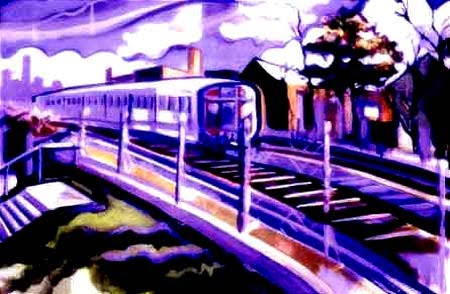Thursday, September 2, 2010
Moving Freight & Passengers
In just over a week, experts and professionals in intercity passenger and freight rail will gather in Denver at the USA RAIL 2010 Conference to discuss the direction of railroading in the United States and some of the recent and ongoing legislative and policy activities to support increased high-speed and intercity passenger rail in the nation. A series of speakers and presenters from Amtrak, freight railroads and public agencies will consider topics such as capital and investment, infrastructure needs, intermodalism and other important elements that must combine to form a cohesive approach to the nation's rail network.
The meeting provides a timely forum to discuss the increasing concern that has developed recently about the impact of current and forthcoming high-speed and intercity passenger rail projects will have on the American freight rail network. The number of new corridors that will install true high-speed infrastructure will be limited – likely to those in Florida and California – at least initially. Accordingly, most of the remaining projects will involve some interaction with freight lines.
Freight railroads are nervous after the U.S. Department of Transportation has suggested that they may be liable to reimburse the federal government for upgrades to their infrastructure supported through ARRA and other sources if passenger trains do not achieve pre-agreed upon reliability and performance measures. Moreover, mandates to install positive train control on routes shared with passenger trains stemming from the Passenger Rail Improvement and Investment Act of 2008 have not been matched with public investment to support these technological upgrades.
But, more importantly, as recent analysis from The Economist and Transport Politic suggest, attempts to achieve both significantly improved intercity passenger service and maintain existing freight capacity will be difficult to achieve due to the different operating speeds required by the two modes. Operating passenger trains too slow and freight trains too fast benefits neither sector and wastes the efficiency and revenue centers of both. So, while co-mingling passenger and freight traffic is fiscally possible on routes with fewer than a half-dozen or so daily passenger trips, when passenger frequency increases, significant passenger-only infrastructure is often necessary.
Because of this reality, some observers suggest that a broad effort to improve passenger rail in the United States are futile because most will not be able to achieve true high-speed status and others claim it will impose substantial disadvantages to the freight network, which is, indeed, a well-established, economically-successful and environmentally-friendly way of moving goods and materials that is unmatched elsewhere in the world. It's also one for which the United States receives too little credit by international and domestic commentators.
However, to suggest such a zero-sum game – to build massively expensive high-speed infrastructure or essentially maintain the status quo of freight traffic dominance – as the only possible outcome is a shortsighted view of policy-making. Indeed, in some cases, only incremental increases will be possible, like the new services being planned for Ohio's 3-C corridor or between Milwaukee and Madison. However, those projects also represent restoration of service absent for more than three decades, so any increase is an infinite upgrade. And the true high-speed projects in California and Florida will demonstrate the potential of the technology, which can be adapted to additional corridors later. But there will still be opportunities for conventional – non high-speed – services that can benefit both intercity passenger and freight interests. In fact, these types of efforts have already found a model for success at the commuter rail level.
Commuter rail systems such as the Trinity Railway Express between Dallas and Fort Worth, the Caltrain service between San Francisco and San Jose, the New Mexico Rail Runner serving Albuquerque and Santa Fe, and the Utah Transit Authority's Front Runner between Ogden and Salt Lake City all represent conventional rail applications that offer outstanding frequency while also co-mingling with freight traffic or along dedicated tracks along freight corridors. Each service operates at least a dozen roundtrips on weekdays in multiple directions with off-peak trips at midday or in the evenings. Meanwhile, their tracks are available to accommodate freight traffic either at the same time or at segregated periods, maximizing the efficiency and functionality of these corridors. The key similarity among these systems in various parts of the country is public control over the rail infrastructure, meaning their commuter trains are not delayed by freight trains with greater priority. At the same time, the State of North Carolina owns the railroad that connects its major cities of Raleigh-Durham, Greensboro and Charlotte, which has allowed North Carolina to add frequencies, train speeds and reliability to its state-sponsored Amtrak trains such as the Piedmont and Carolinian.
In this framework, projects supported by ARRA in Illinois and Virginia will add dedicated track to support increased frequency and speed, while Oregon and Washington as well as New York are planning similar improvements to their existing Amtrak services, the Cascades and Empire Service, respectively. These efforts – while certainly not instituting high-speed rail – will offer greatly enhanced intercity passenger rail service while also improving the infrastructure available to freight trains. It is an important first step to make to help larger sections of our society become familiar with intercity rail travel before the significant investment needed for high-speed projects is secured.
The perfect is not the enemy of the good, and this notion must be continually re-emphasized as the nation undertakes its reinvestment and revitalization of its intercity passenger rail network.
Subscribe to:
Post Comments (Atom)







Great Information sharing .. I am very happy to read this article .. thanks for giving us go through info.Fantastic nice. I appreciate this post. freight transport
ReplyDelete